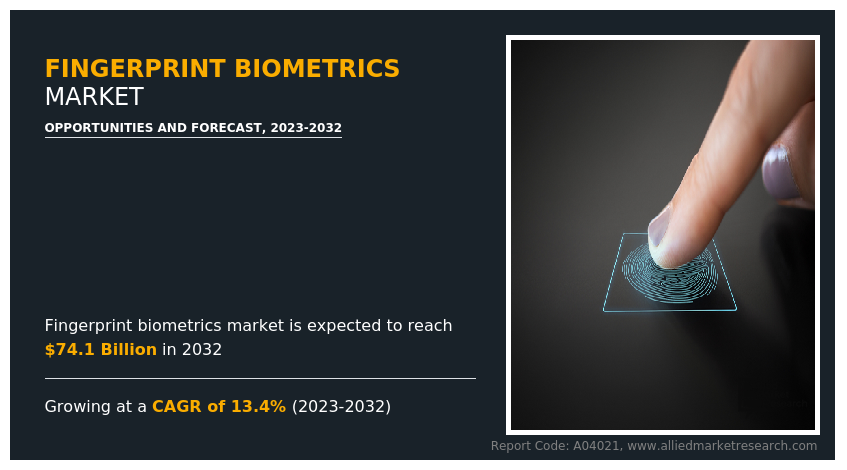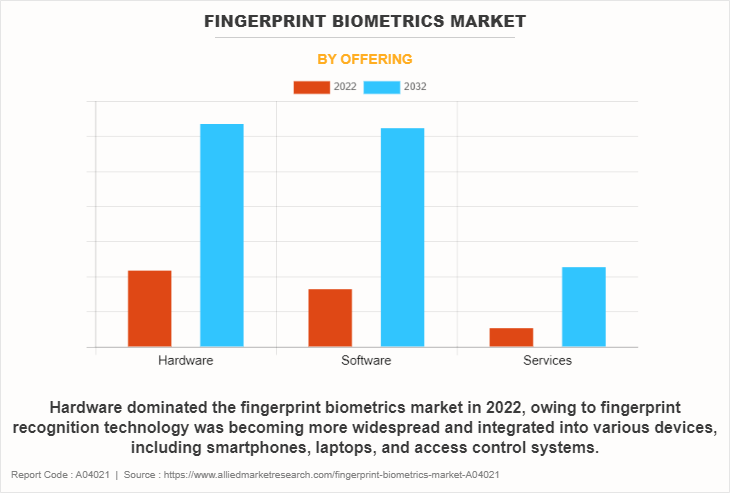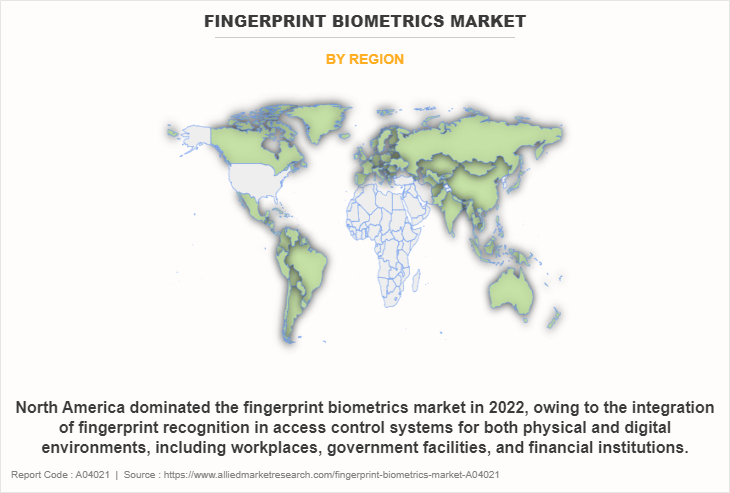Fingerprint Biometrics Market Insights: 2032
The global fingerprint biometrics market was valued at $21.6 billion in 2022, is projected to reach $74.1 billion by 2032, growing at a CAGR of 13.4% from 2023 to 2032.
The fingerprint biometrics market is expected to witness notable growth owing to surge in penetration of user identification devices and increased spending in the defence sector. Moreover, key technological developments leading to the commodification of biometrics is expected to provide lucrative opportunity for the growth of the market during the forecast period. On the contrary, operational concerns related to privacy, security, and ROI limits the growth of the fingerprint biometrics market.

Fingerprint biometrics refers to the use of unique patterns found on an individual’s fingertips to identify and authenticate their identity. These patterns, known as ridges and valleys, are distinct for each person and remain unchanged throughout their lives. In everyday life, fingerprint biometrics plays a crucial role in ensuring security and establishing trust. It is commonly used in various domains, such as unlocking smartphones, accessing secure areas, and performing financial transactions.
Fingerprint biometrics provides a highly reliable and convenient means of authentication, as it is difficult to forge or replicate someone’s fingerprints. Fingerprint biometrics not only enhances personal security but also streamlines daily activities by eliminating the need for remembering passwords or carrying physical identification cards. Its ease of use and accuracy make fingerprint biometrics an essential aspect of modern life, safeguarding personal information and simplifying authentication processes.
The seamless integration of fingerprint recognition into mobile devices, where it has become a standard feature for secure and convenient authentication. The global shift toward contactless solutions, accelerated by the COVID-19 pandemic, has further fueled the adoption of touchless fingerprint recognition methods, ensuring a hygienic and user-friendly experience. Multimodal biometrics, combining fingerprint data with other biometrics identifiers such as facial or iris recognition, gained traction to enhance overall security by requiring multiple forms of authentication.
Another notable trend involves the implementation of liveness detection technologies to counter potential spoofing attempts, addressing a critical security concern. Furthermore, the integration of fingerprint biometrics into payment cards has emerged, bolstering the security of financial transactions.
The fingerprint biometrics market is segmented on the basis of component, type, end user, and region. On the basis of component, the market is categorized into hardware, software, and services. By type, it is divided into AFIS technology and Non-AFIS technology. On the basis of end user, the market is segregated into BFSI, healthcare, travel and tourism, IT and telecom, government & defense, automotive, and others. By region, the market is analyzed across North America, Europe, Asia-Pacific, Latin America, and Middle East and Africa.
The report focuses on growth prospects, restraints, and analysis of the global fingerprint biometrics market trends. The study provides Porter’s five forces analysis to understand the impact of various factors, such as bargaining power of suppliers, competitive intensity of competitors, the threat of new entrants, threat of substitutes, and bargaining power of buyers on the global fingerprint biometrics market analysis.

On the basis of offering, the hardware segment dominated the fingerprint biometrics market size in 2022, owing to fingerprint recognition technology was becoming more widespread and integrated into various devices, including smartphones, laptops, and access control systems. Manufacturers were focusing on improving the resolution and sensitivity of fingerprint sensors to ensure more reliable and secure authentication. However, the services segment is expected to witness the fastest growth, owing to the use of fingerprint biometrics in healthcare services, providing secure access to patient records and ensuring the accuracy of medical information.
Moreover, the deployment of fingerprint technology in access control systems for buildings and secure facilities has gained momentum, enhancing physical security measures. As technology continues to evolve, the integration of fingerprint biometrics with artificial intelligence and machine learning is expected to further improve accuracy, speed, and overall reliability, expanding its applications in a wide range of services, from law enforcement to e-commerce.

Region-wise North America dominated the fingerprint biometrics market share in 2022, owing to the integration of fingerprint recognition in access control systems for both physical and digital environments, including workplaces, government facilities, and financial institutions. The increased emphasis on security and identity verification fueled the deployment of fingerprint biometrics in smartphones, laptops, and other personal devices.
However, Asia-Pacific is expected to witness the fastest growth in the upcoming year, owing to the surge in the implementation of fingerprint biometrics for financial transactions, access control, and workforce management, reflecting a growing emphasis on security and efficiency. Mobile devices equipped with fingerprint sensors became commonplace, contributing to the seamless integration of biometrics into daily life. Governments and businesses in the region were investing in research and development to enhance the accuracy and reliability of fingerprint recognition systems.
Top Impacting Factors:
Surge in Penetration of User Identification Devices
The surge in the penetration of user identification devices for fingerprint biometrics is driven by several factors that collectively address the evolving needs of modern societies. One crucial aspect is the increasing awareness and prioritization of data security. Fingerprint biometrics offer a highly secure means of user identification, as each person's fingerprint is unique, making it significantly more challenging for unauthorized access. The convenience factor plays a pivotal role in this surge as well.
With fingerprint sensors becoming a standard feature in smartphones and other personal devices, users are provided with a quick and frictionless method for unlocking their devices, authorizing transactions, and accessing sensitive information. This seamless integration aligns with the demand for user-friendly experiences, eliminating the need for complex passwords or PINs. Industries that handle sensitive information, such as finance and healthcare, are adopting fingerprint biometrics to enhance their security protocols. Financial transactions, account access, and medical records are safeguarded through the use of biometrics data, providing an additional layer of protection against identity theft and unauthorized access.
Governments are also leveraging fingerprint biometrics for various applications, including national identification systems, border control, and law enforcement. This technology enables accurate and efficient identity verification, contributing to improved public safety and streamlined administrative processes. Furthermore, advancements in technology have led to the development of more sophisticated fingerprint recognition algorithms, addressing previous concerns about false positives and negatives. These improvements contribute to the reliability and accuracy of user identification devices, fostering trust in the adoption of fingerprint biometrics across diverse sectors.
Increased Spending in the Defence Sector
The increased spending in the defense sector for fingerprint biometrics is driven by a recognition of the unique advantages this technology offers in addressing the complex challenges faced by modern military and defense establishments. Fingerprint biometrics provide a highly secure and efficient method of individual identification, ensuring that only authorized personnel have access to sensitive areas, classified information, and advanced military technologies. The technology plays a pivotal role in bolstering physical security by replacing or complementing traditional access cards or PIN-based systems, thereby minimizing the risk of unauthorized entry and potential security breaches.
Moreover, the adoption of fingerprint biometrics in defense extends beyond basic access control. It serves as a crucial tool for personnel management, enabling accurate tracking of military personnel and contractors in dynamic operational environments. This capability enhances overall situational awareness, facilitates rapid response to emergencies, and ensures that the right individuals are assigned to specific roles based on their verified identities. With the increasing digitization of military operations, securing digital assets becomes paramount.
Fingerprint biometrics help safeguard sensitive information, secure communication networks, and prevent unauthorized access to digital systems, reducing the vulnerability of defense infrastructure to cyber threats. In addition, the adoption of fingerprint biometrics aligns with global efforts to standardize and strengthen security practices. International defense collaborations and partnerships often involve the exchange of personnel and information, and a standardized biometrics authentication system facilitates seamless interoperability between different defense agencies.
Competition Analysis:
Competitive analysis and profiles of the major players in the fingerprint biometrics industry include Thales, Bio-Key International, HID Global Corporation, M2SYS Technology, NEC Corporation, IDEMIA, Anviz Global Inc., DERMALOG Identification Systems GmbH, Fingerprint Cards AB, and FingerCheck. Major players have adopted product launch, partnership, collaborations, and acquisition as key developmental strategies to improve the product portfolio and gain strong foothold in the fingerprint biometrics industry.
Recent Partnership in the Fingerprint Biometrics Market:
On June 2023, BIO-key International, Inc., an innovative provider of Identity and Access Management (IAM) solutions featuring Identity-Bound Biometrics (IBB), partnered with Savvy Information Technology to bring BIO-key solutions to customers in Ethiopia. The Savvy partnership expands the global reach of BIO-key’s Channel Alliance Partner (CAP) within Ethiopia, Africa's second most populous country and one of the fastest-growing economies in the world.
On March 2023, BIO-key International, Inc., an innovative provider of Identity and Access Management (IAM) solutions featuring Identity-Bound Biometrics (IBB), partnered with Ethnos IT Solutions to bring innovative IAM solutions to customers across Africa who are looking to enhance their cybersecurity with improved access security and seamless user experiences.
On November 2023, Idemia partnered with Home Team Science and Technology Agency (HTX), the technology department of Singapore’s Ministry of Home Affairs, to develop biometrics and forensic products to be used for homeland security.
Recent Product Launch in the Fingerprint Biometrics Market:
In October 2023, Thales has launched a new biometrics smart card for enterprise access control. The SafeNet IDPrime FIDO Bio Smart Card features an embedded fingerprint sensor and NFC capabilities and is aimed at security access both to physical venues and to IT assets.
Key Benefits for Stakeholders
- This report provides a quantitative analysis of the market segments, current trends, estimations, and dynamics of the fingerprint biometrics market analysis from 2022 to 2032 to identify the prevailing fingerprint biometrics market opportunities.
- The market research is offered along with information related to key drivers, restraints, and opportunities.
- Porter's five forces analysis highlights the potency of buyers and suppliers to enable stakeholders make profit-oriented business decisions and strengthen their supplier-buyer network.
- In-depth analysis of the fingerprint biometrics market forecast to determine the prevailing market opportunities.
- Major countries in each region are mapped according to their revenue contribution to the global market.
- Market player positioning facilitates benchmarking and provides a clear understanding of the present position of the market players.
- The report includes the analysis of the regional as well as global fingerprint biometrics market growth, key players, market segments, application areas, and market growth strategies.
Fingerprint Biometrics Market Report Highlights
| Aspects | Details |
| Forecast period | 2022 - 2032 |
| Report Pages | 345 |
| By Type |
|
| By Offering |
|
| By End User |
|
| By Region |
|
| Key Market Players | IDEMIA, M2SYS Technology, Bio-Key International, FingerCheck, Thales, Fingerprint Cards AB, DERMALOG Identification Systems GmbH, NEC Corporation, HID Global Corporation, Anviz Global Inc. |
Analyst Review
The uniqueness of fingerprints among individuals is a fundamental aspect that contributes to the reliability of this biometrics method. The distinct ridges, swirls, and minutiae patterns on each person's fingertip create a foolproof means of identification. In addition, the permanence of fingerprints throughout a person's life further ensures the consistency of the biometrics data. Analysts appreciate the practicality and user-friendly nature of fingerprint biometrics. The process of scanning and matching fingerprints is quick and non-intrusive, making it efficient for identity verification in various applications, ranging from unlocking smartphones to accessing secure facilities. This efficiency is crucial in a world where seamless and rapid authentication processes are increasingly essential.
Furthermore, advancements in fingerprint biometrics technology have addressed concerns related to potential vulnerabilities. Features such as liveness detection, which ensures that the fingerprint being presented is from a living person and not a replicated image, enhance the security of these systems. In addition, the implementation of multi-factor authentication, combining fingerprint data with other verification methods, adds an extra layer of protection against unauthorized access. Despite the positive aspects, analysts also recognize challenges and potential drawbacks associated with fingerprint biometrics. Privacy concerns arise due to the collection and storage of sensitive biometrics data. Ensuring robust security measures to protect stored biometrics information is imperative to prevent unauthorized access or potential misuse. Ethical considerations regarding the responsible use and sharing of biometrics data also need to be addressed to maintain public trust.
In conclusion, fingerprint biometrics offers a reliable and efficient method of identity verification. Technology’s continuous evolution to address security concerns and privacy issues is crucial for its widespread acceptance and integration into various aspects of daily life. As analysts closely monitor these developments, the consensus remains positive regarding the role of fingerprint biometrics in enhancing security and user experience across diverse applications.
The global fingerprint biometrics market generated $96,861.52 million in 2022, and is estimated to reach $440,213.3 million by 2032, witnessing a CAGR of 16.7% from 2023 to 2032.
North America is the largest regional market for Fingerprint Biometrics
Competitive analysis and profiles of the major players in the fingerprint biometrics industry include Thales, Bio-Key International, HID Global Corporation, M2SYS Technology, NEC Corporation, IDEMIA, Anviz Global Inc., DERMALOG Identification Systems GmbH, Fingerprint Cards AB, and FingerCheck.
Key technological developments leading to the commodification of biometrics is the leading application of Fingerprint Biometrics Market.
Surge in penetration of user identification devices and increased spending in the defence sector are the upcoming trends of Fingerprint Biometrics Market in the world.
Loading Table Of Content...
Loading Research Methodology...



